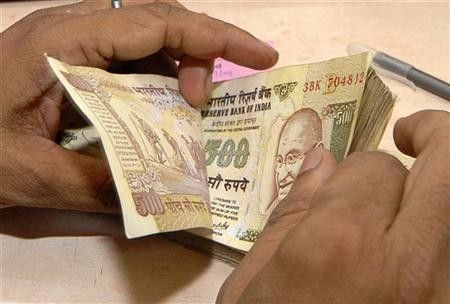Rupee, Market Hit By India's Q4 GDP Data

The Q4 GDP data for India plunged the volatile rupee further in the morning trade Thursday, as the Indian currency hovered near an all-time low of 56.52 against the dollar. The rupee was trading at 56.38/39 at 10 am IST, after testing the 56.52 level in early trade.
Traders are expecting that the RBI will intervene in the Forex market due to fear that the stronger dollar will further drag down the rupee.
In a gaining dollar scenario, it is difficult for any currency to hold its position. Exporters also seem to be holding back and positioning for a further fall, Naveen Raghuvanshi, associate vice president of foreign currency trading at the Development Credit Bank, told the Economic Times.
Indian markets also reacted sharply to the GDP data as the 30-share BSE Sensex crashed 225 points to 16,086 immediately after the GDP figure was announced. However, markets recovered from GDP shocks in the early post-noon trade, but were still trading in the red.
Top losers in NSE were Tata Motors (4.1 percent), ICICI Bank (4 percent), Maruti Suzuki (3.5 percent) and Reliance Industries (2 percent).
Markets may now have to deal with a tail event as the macro environment gets challenging and conviction in earnings outlook is low, said Ridham Desai of Morgan Stanley on CNBC TV18.
BSE Sensex was at 16,172.66, 140 points or 0.80 percent down and NSE Nifty was trading at 4915.55, 35.20 points or 0.71 percent less from the previous day's close at 1.45 pm IST.
CNX Midcap index lost 0.3 percent and BSE Small-Cap index was down 0.7 percent. The market breadth was negative with advances at 494 against declines of 824 on the NSE.
Analysts believe that the market will recover from the losses, speculating immediate government action to boost the economy. However, the economic slowdown and the high inflation make it difficult for the government and the RBI to take drastic actions.
Incrementally, the growth slowdown will probably take up more space in policy making and we expect RBI to continue with modest easing. I think after this data, market may come to a view of closer to 50-75 basis point rate cut in rest of the fiscal year, which is also our view, from 25 basis points factored in now, Rahul Bajoria, regional economist, Barclays Capital in Singapore, told Reuters.
The data also poses a dilemma for policy makers, as they have no fiscal room to stimulate growth, while monetary easing scope is very narrow, at least for now, due to rebounding and high inflation, Reuters quoted Dariusz Kowalczyk, economist, Credit Agricole CIB, Hong Kong, as saying.
© Copyright IBTimes 2024. All rights reserved.





















